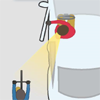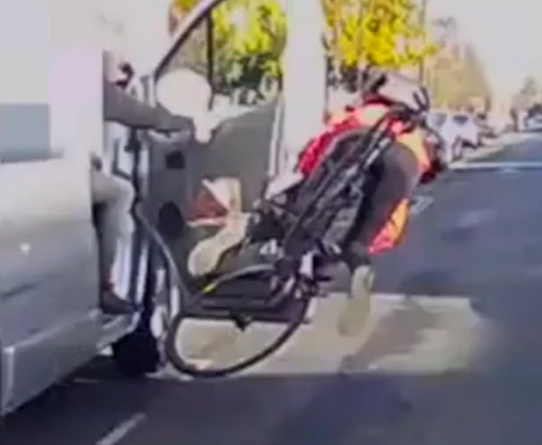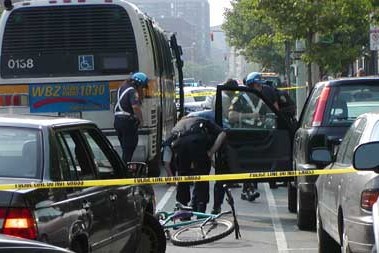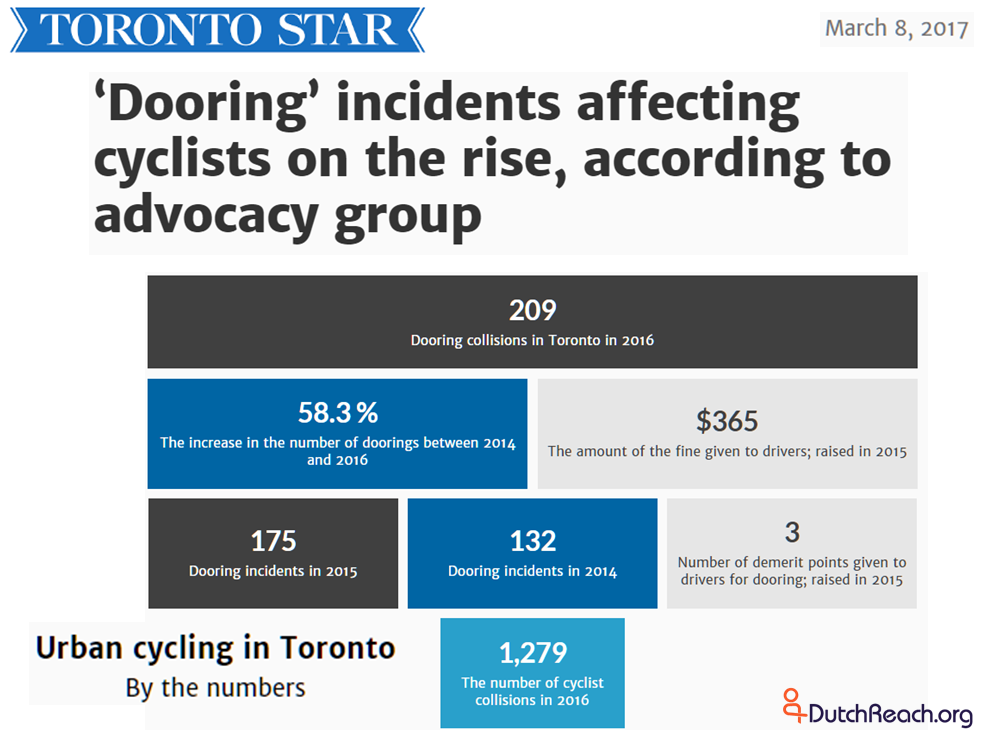In Germany
"Every second accident between a cyclist and a car that is related to parking is a "dooring" incident, warns the expert from the UDV, which belongs to the Association of the German Insurance Industry."
In Australia
For dooring statistics in Victoria, Australia as of 2019 see VicRoads/ Car doors & bike riders. Dooring study in Melbourne, Victoria in 2012: Bicycle Rider Collisions with Car Doors, Road Safety Action Group - Inner Melbourne. Share and Be Aware, Road Safety Action Grouop submission 2013. A multi-stage, multi-faceted approach to addressing ‘car dooring’ in inner Melbourne, Bolitho, J11, Road Safety Action Group Inner Melbourne, 2013. VicRoads updated statistics on dooring 2014-2019.
Dooring: Often the most common bike-motor vehicle collision in urban areas
Defining and measuring the incidence, prevalence or proportionality of doorings, crashes, injuries and fatalities is difficult and various (see Caveats note below). Even so, several cities in North America report doorings (however variously defined or collected) among their top three causes of bicycle - vehicle collisions.
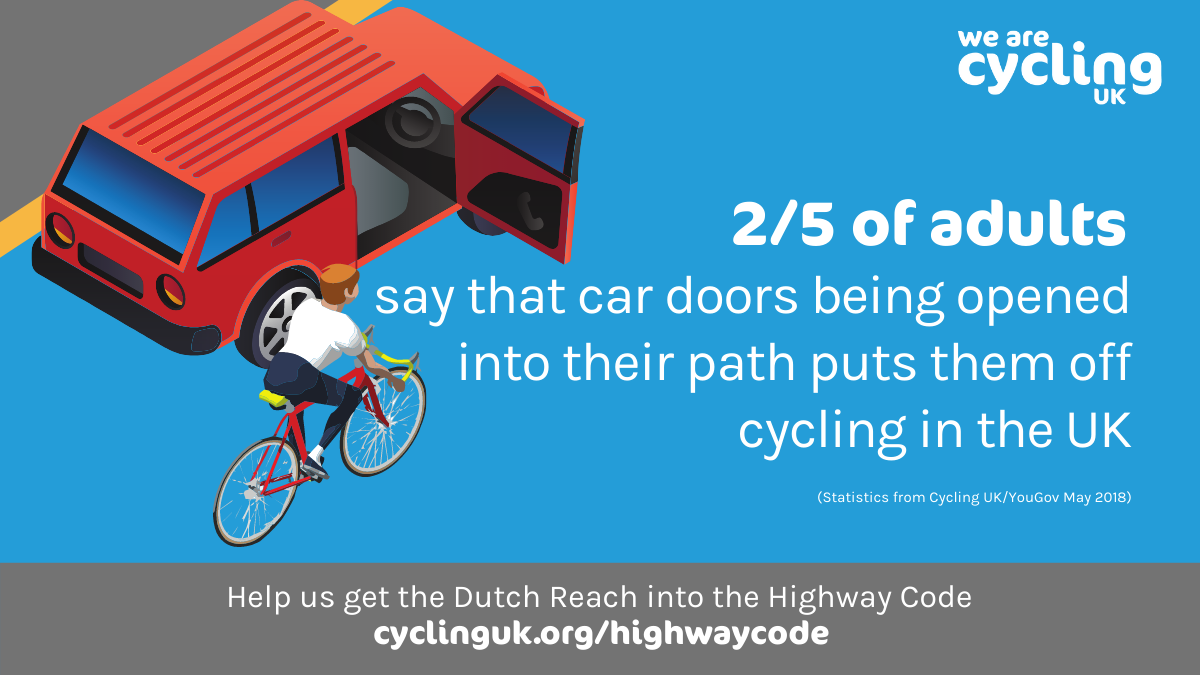
Dooring fear discourages potential cyclists, Cycling UK, Sept 15, 2020.
Ambush Conditions
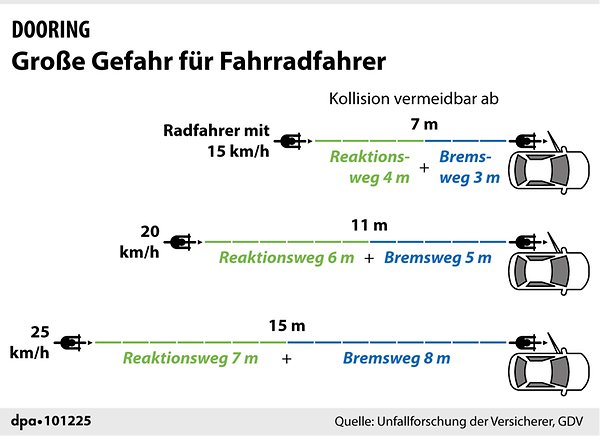
Distances required at various speeds for cyclist to avoid a 'dooring'. GDV test findings. Click to enlarge.
Belgian Dooring Stats
#Dooring is the 2nd most common bicycle crash in Brussels https://t.co/vhre9ZVySR #dutchreach #bikes #drivers #parking #bikelane #doorzone #visonzero #criticalmass #dot #cycling #bike2work #school #safestreets #cars #autos #taxis #uber #license #driversed #roadsafety #habit
— Michael Charney (@DutchReach) February 23, 2023
Montreal Cananda Dooring Statistics
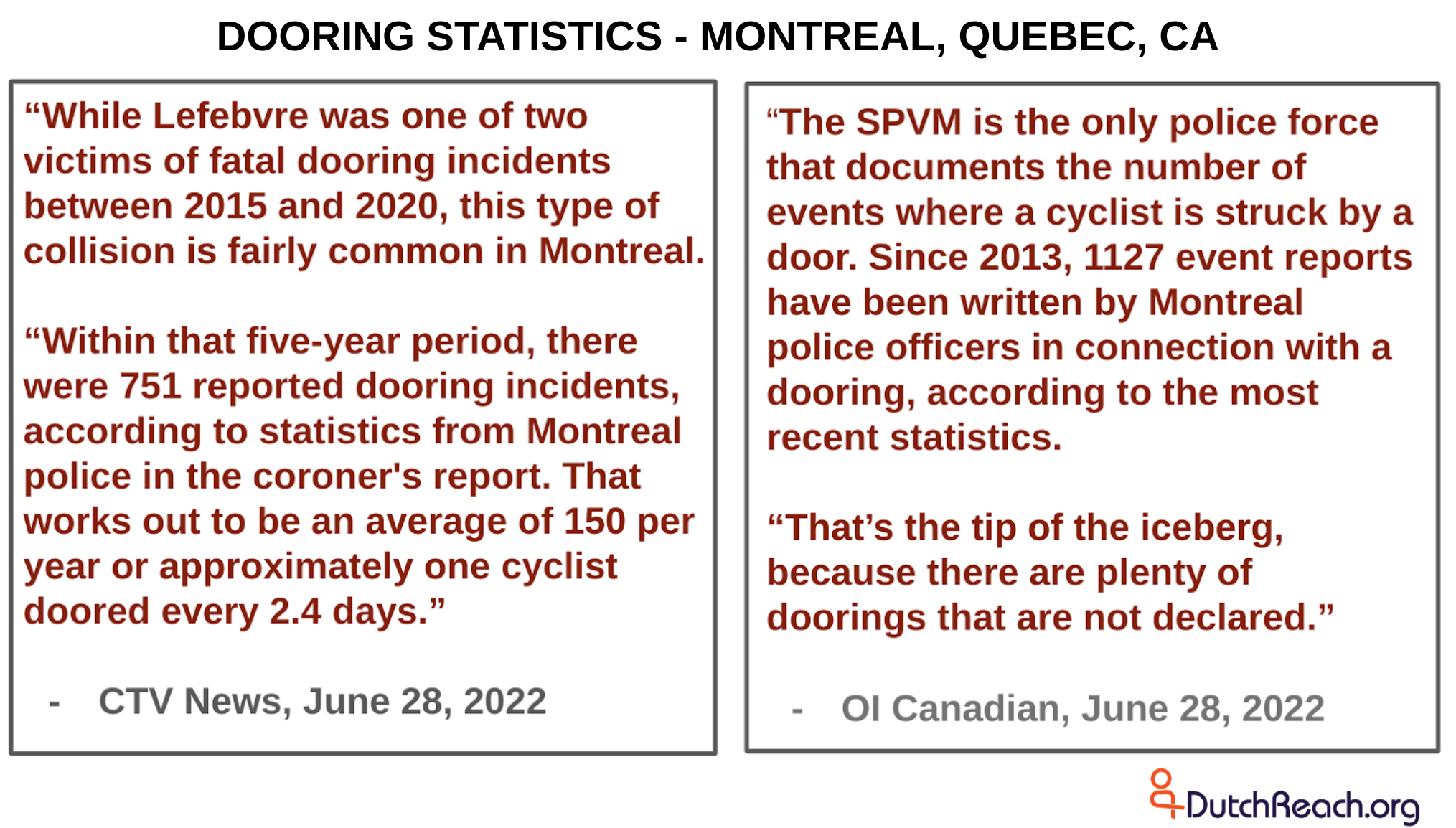
Dooring statistics for Montreal, Quebec, Canada. Sources: CTV News, OICanadian & SPVM, 28 June 2022.
Belgium
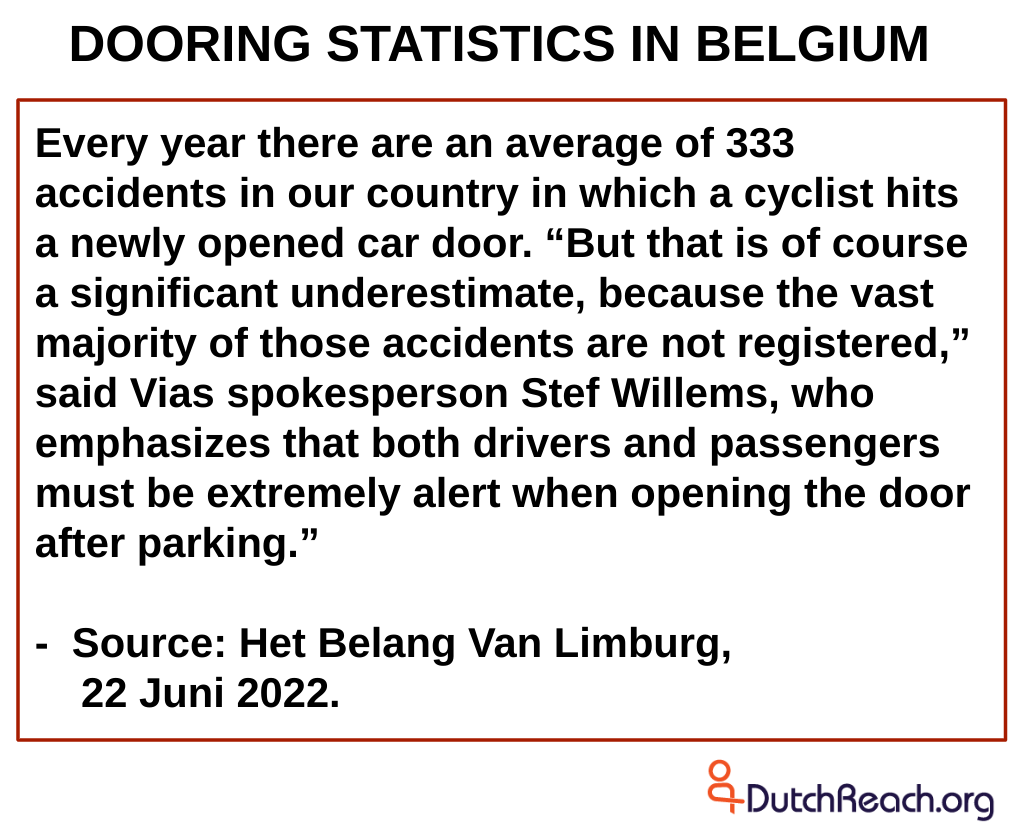
Reported ooring statistics in Belgium average 333 per year but is likely a significant underestimate. Het Belang Van Limburg, BE,
22J une 2022.
San Francisco - Doorings - Pie Chart
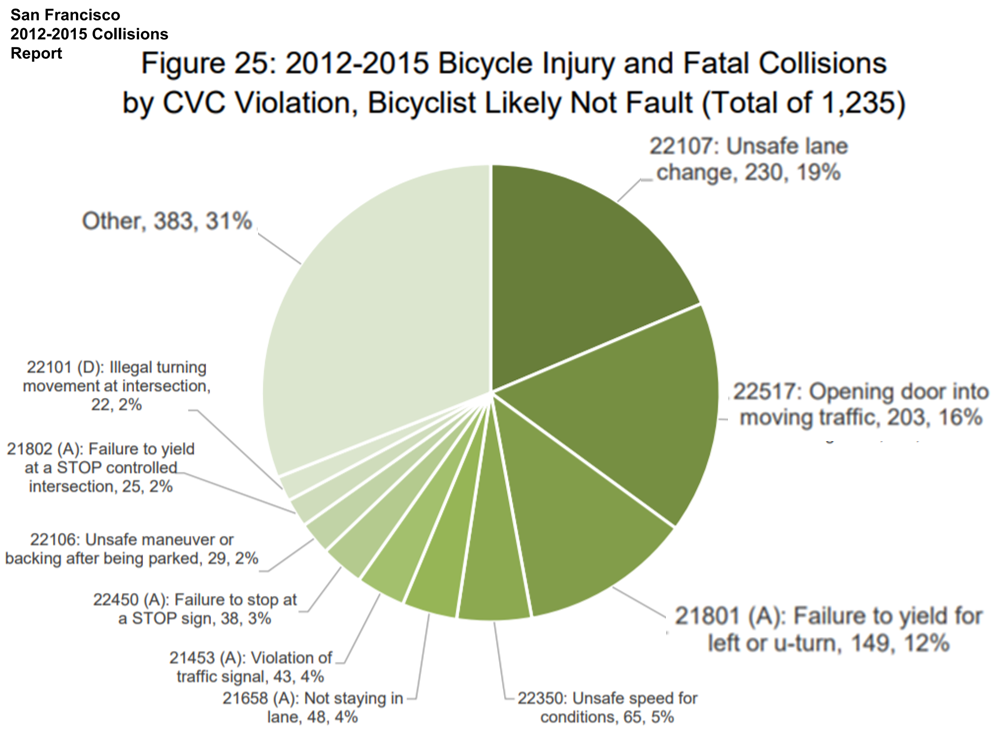
Pie Chart: 2012-2015 Bicycle Injury and Fatal Collisions by CVC Violation, Bicyclist Likely Not Fault. San Francisco 2012-2015 Collisions Report (SFMTA 2016) p. 36.
San Francisco -- Doorings - Table
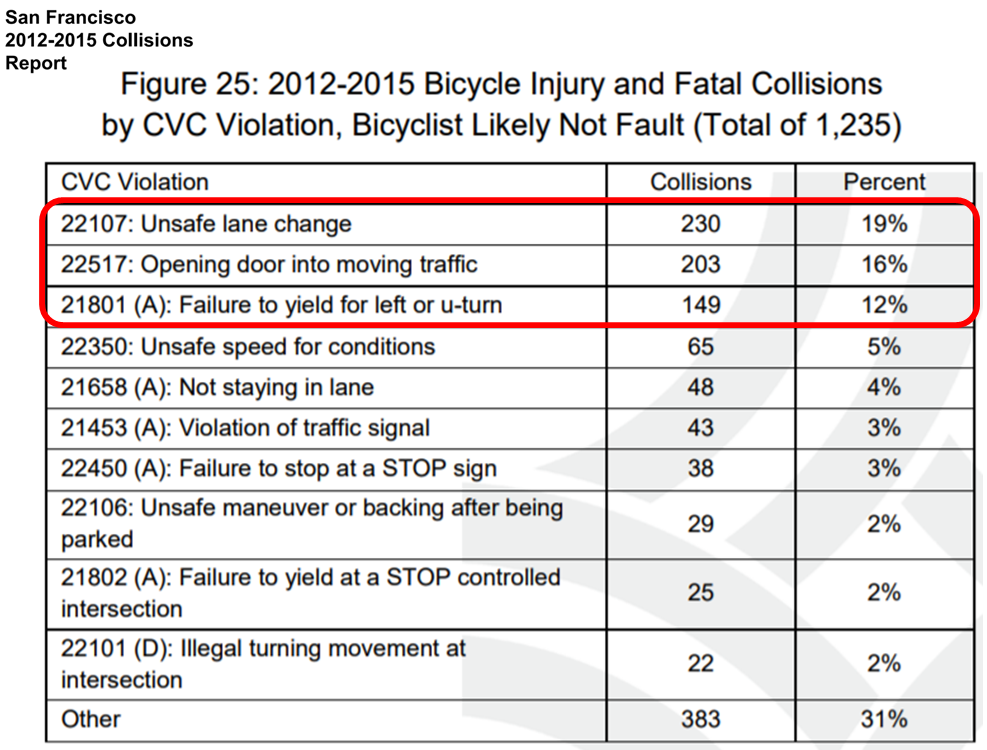
Table: 2012-2015 Bicycle Injury and Fatal Collisions by CVC Violation, Bicyclist Likely Not Fault. San Francisco 2012-2015 Collisions Report (SFMTA 2016) p. 36,
Cambridge, MA, USA - Bike Crash Pie Chart
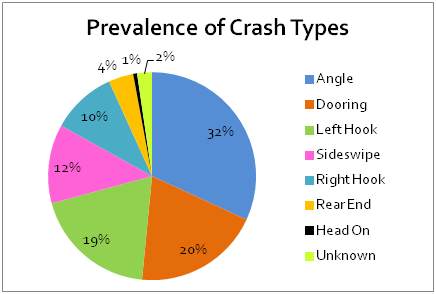
Bike Crash Types - Updated 2015, Community Development Dept., City of Cambridge, MA, USA . Doorings account for 1/5th of motor vehicle v bicycle crashes. Click image to enlarge; click here for webpage.
Map of Toronto Dooring Incidents
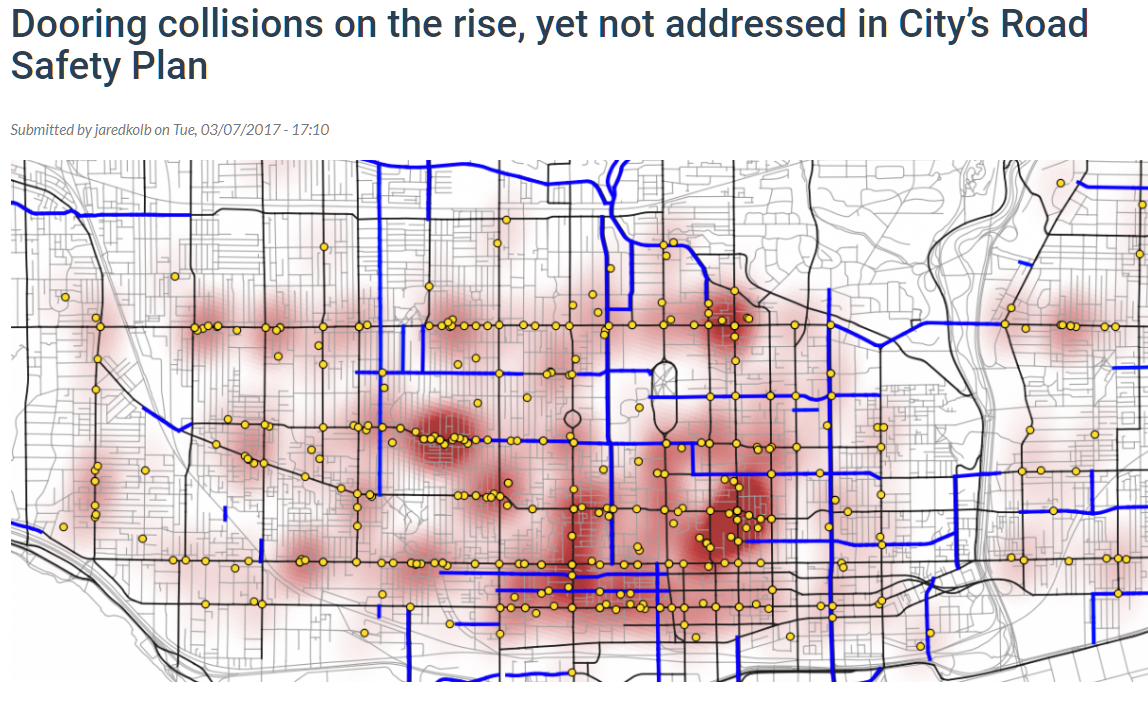
Dooring Locations in Downtown Toronto 2014-2016. Dooring locations denoted with a yellow dot. Blue lines indicate the presence of bicycle lanes. Hot spots in red.. Click image to view article.
2002 Boston Bike Courier Injury Study
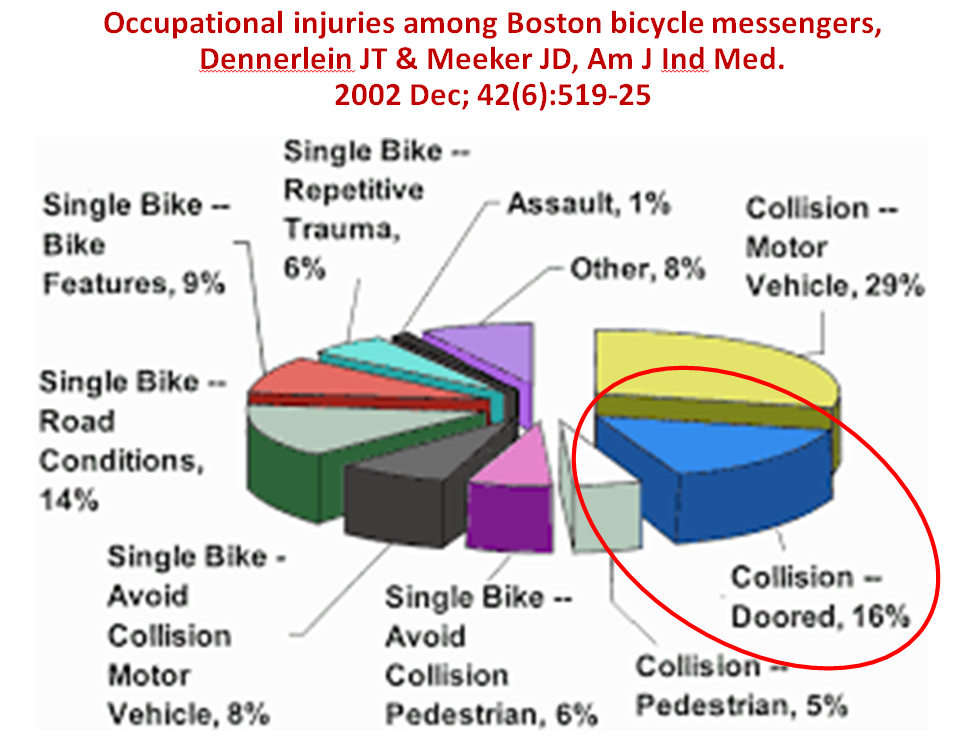
One sixth of bike messenger crash injuries were doorings - Occupational injuries among Boston bicycle messengers, Dennerlein JT & Meeker JD, Am J Ind Med. 2002 Dec; 42(6):519-25. Click to enlarge.
Brussel's Primary Cause of Bike v Vehicle Crashes
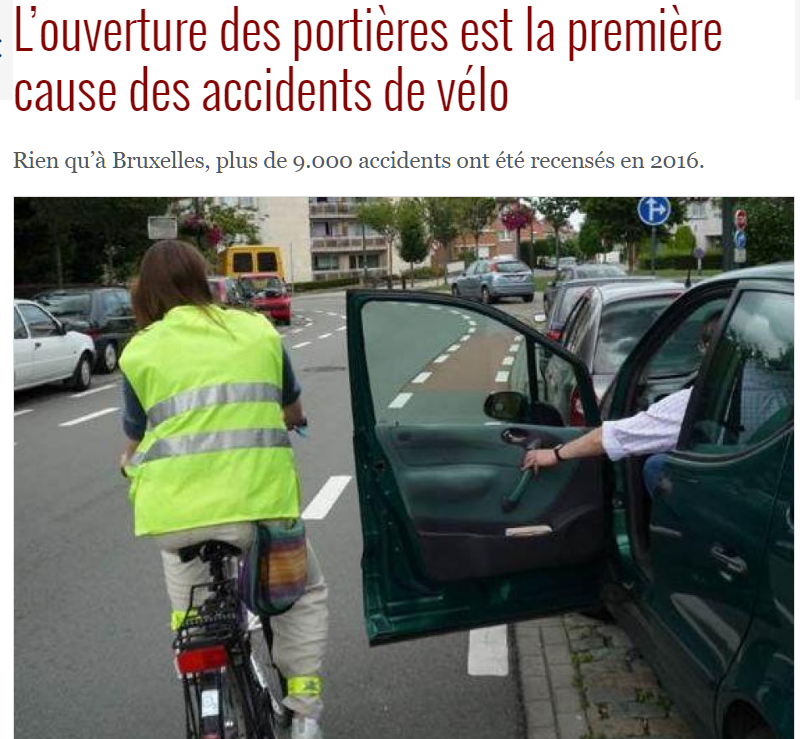
n 2016, doorings were the leading cause of bicycle crashes in the Brussels-Capital Region according to the Belgian Institute for Road Safety. Click here for article.
GDV: Doorings Almost 1 in 5, Not 1 in 20!
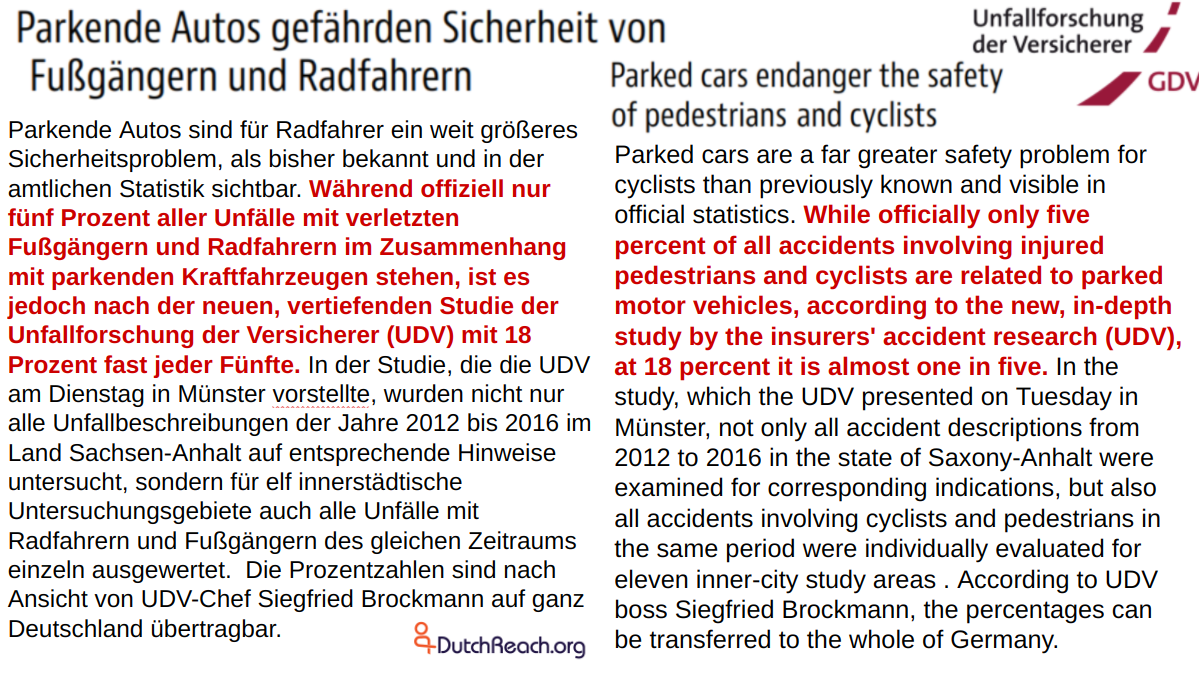
Parkende Autos gefährden Sicherheit von Fußgängern und Radfahrern, UDV,
09.07.2020. [Doorings cause 18% of bike crashes, per new German insurance study].
Doorings 3% of Injurious Traffic Crashes in Köln

German Road Safety Council reports 1472 injured by dooring in Cologne from 2010 to 2020. See also DVR anti-dooring campaign website here.
Motorists Failure to Look - German Survey (DVR)
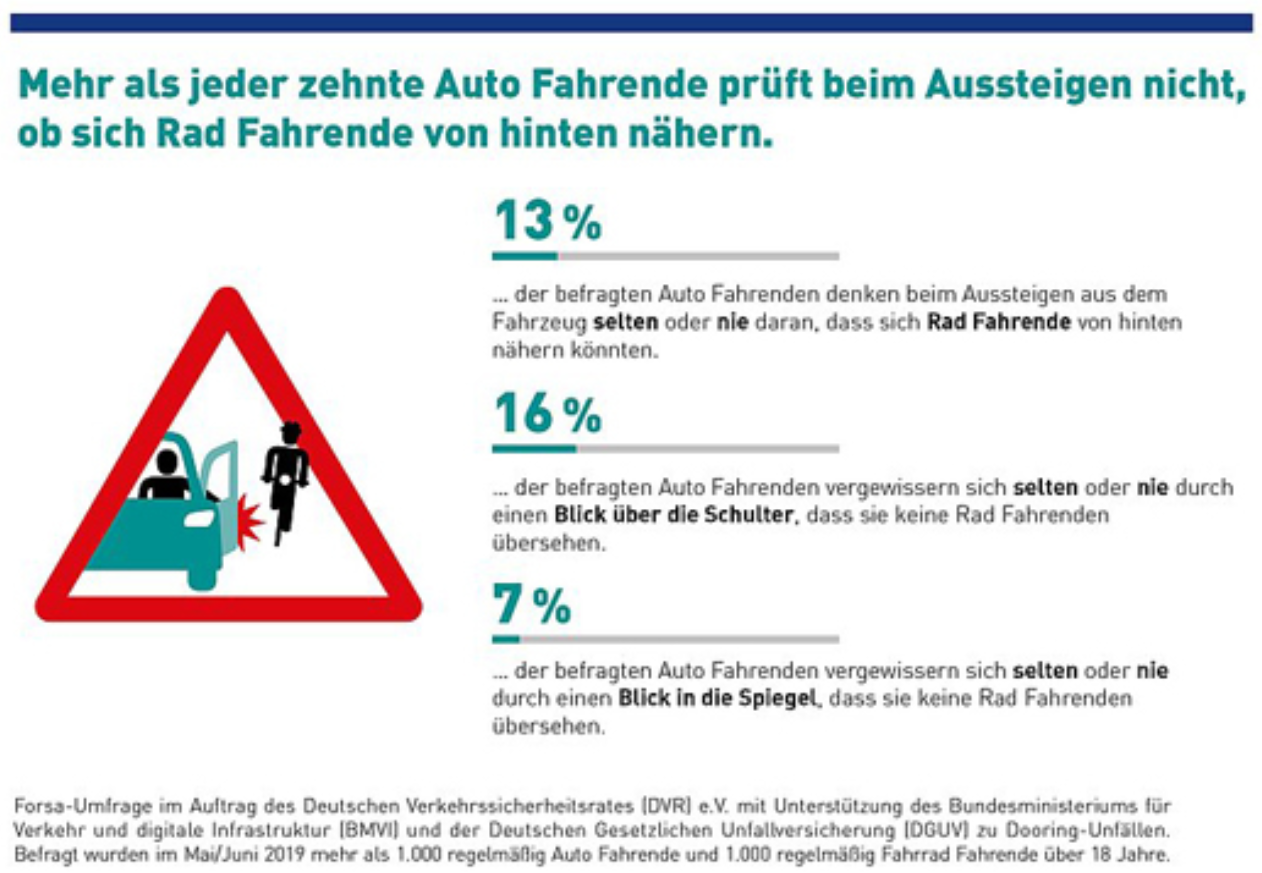
Eine aktuelle Forsa-Umfrage offenbart eine mangelnde Voraussicht von Autofahrern beim Öffnen der Tür und Aussteigen aus einem Fahrzeug. - Verkehrs Erziehung .de, 10 Sept 2019.
Extra-wide Doors Pose Extra Risk
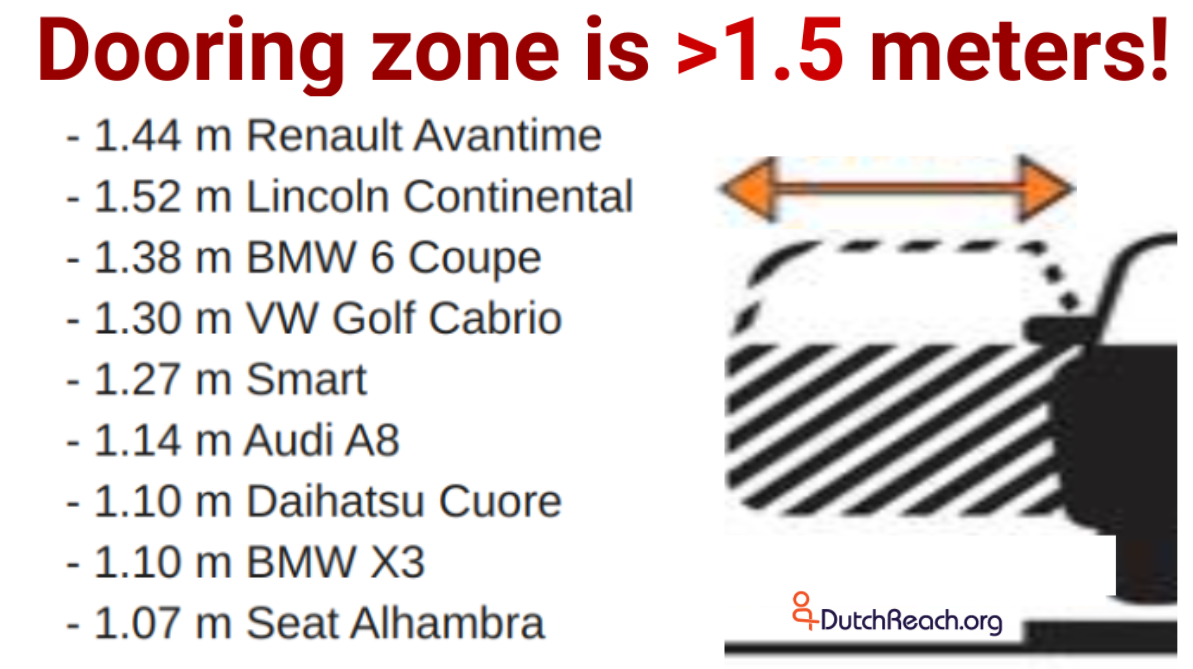
Many vehicle doors exceed 1 meter/1 yard in width. SUVs, trucks, pickups & luxury vehicles pose greater risk. Current bike lane door zones & buffer zones are insufficient for cyclist safety. Chart source here.
DVR Survey of Motorist Exiting Behavior
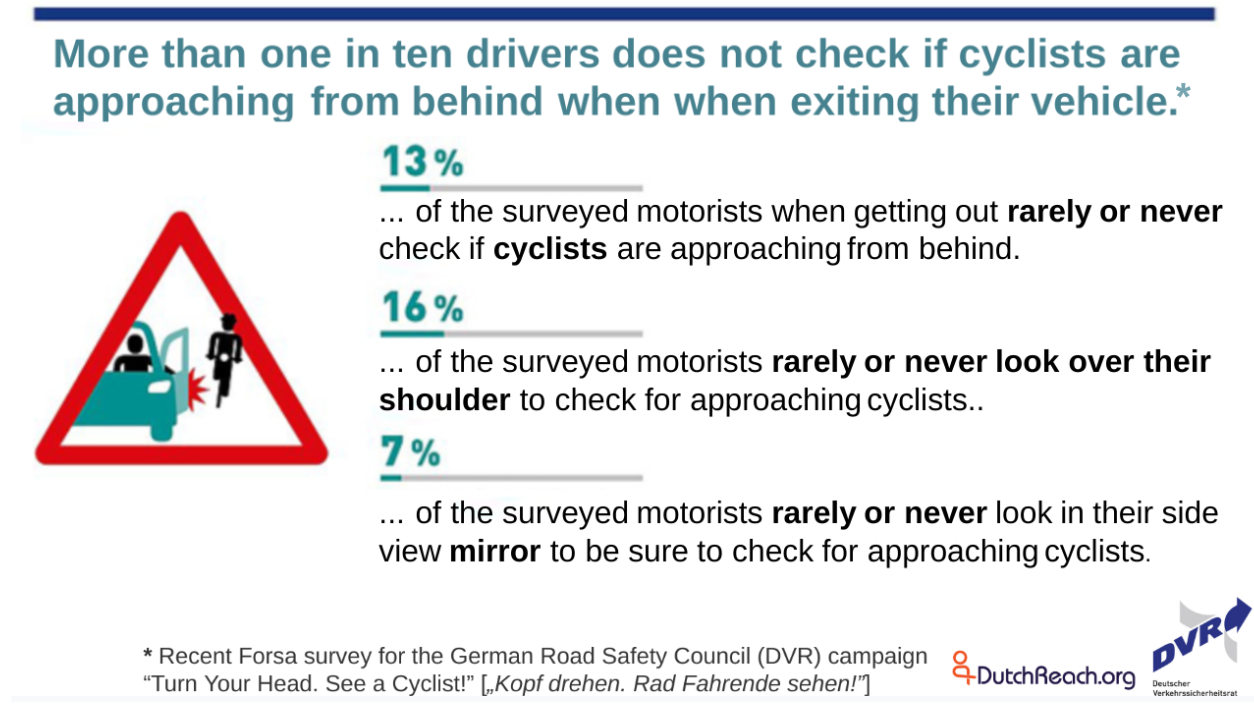
Results of motorist survey regarding measures taken or not when exiting their vehicles to avoid door crashes with oncoming cyclists. Survey performed by Forsa for the German Road Safety Council (DVR) as part of its 2019 safety campaign „Kopf drehen. Rad Fahrende sehen!“ ("Turn head, See Cyclists").
UK Dooring Statistics 2014 - 2018
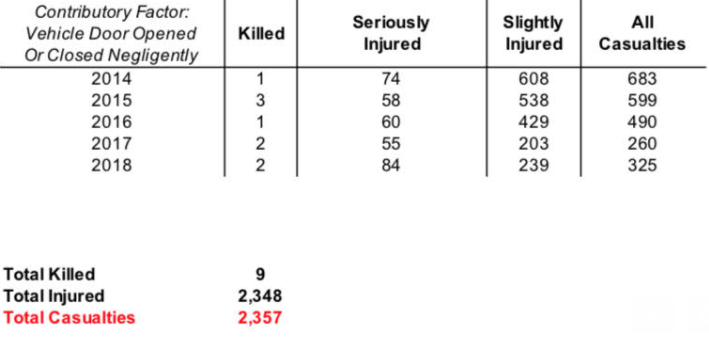
United Kingdom Dooring statistics summarized for 2014-2018. Web source & ffile RAS50007 - Contributory factors: Casualties in reported accidents by severity, GB: from tab for: Vehicle door opened or closed negligently".
35% of UK Motorists Negligent Upon Exiting
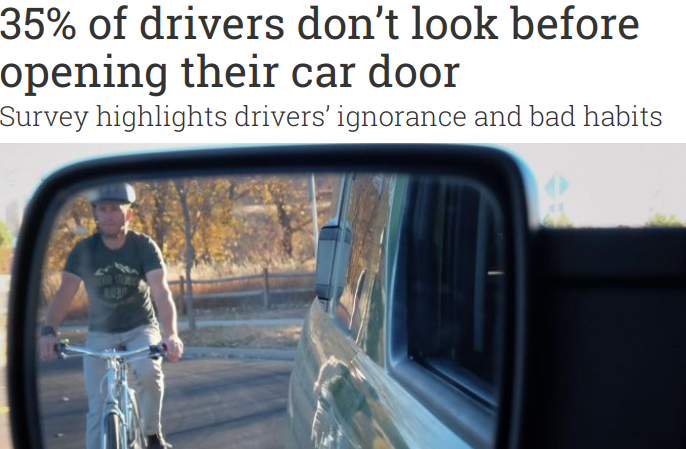
35% of drivers don’t look before opening their car door: A survey by eBikes Direct of 1,000 drivers from across the UK found negligent exiting practices & marked ignorance of cyclists' road rights. Bike Radar, 25 May 2017.
3/5ths of Florida Drivers Admittedly Negligent on Egress
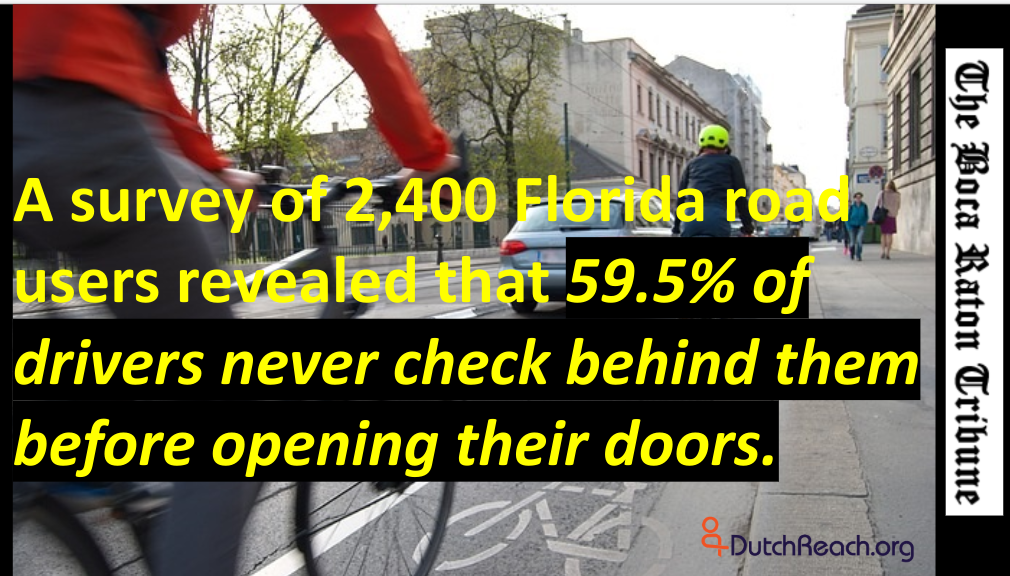
"Correlating with official statistics making Florida a deadly state for cyclists, 56% of cyclists declared that they feel more unsafe using Florida roads than in other states. To emphasize the point, the survey revealed that 59.5% of drivers never check behind them before opening their doors," The Boca Raton Tribune, FL, Feb 25, 2020. Survey by Gunther Volvo..
UK Dooring Statistics 2011-2015
Although the majority of injuries were cyclists, the figures obtained by Cycling UK also show that 34 motorcyclists were seriously injured and 280 slightly injured in that period in Great Britain.
- Motorcycle Minds
San Francisco 2012-2015 Collisions Report
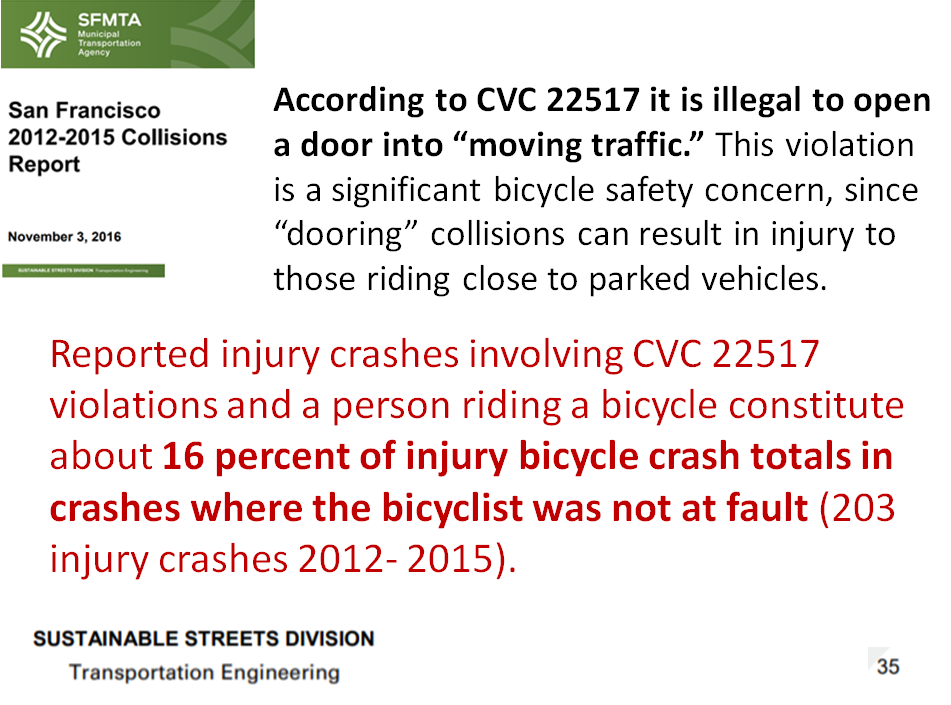
Doorings "constitute about 16 percent of injury bicycle crash totals in crashes where the bicyclist was not at fault," San Francisco
2012-2015 Collisions Report, p.35. Click image to enlarge.
LIVES LOST BY DOORING
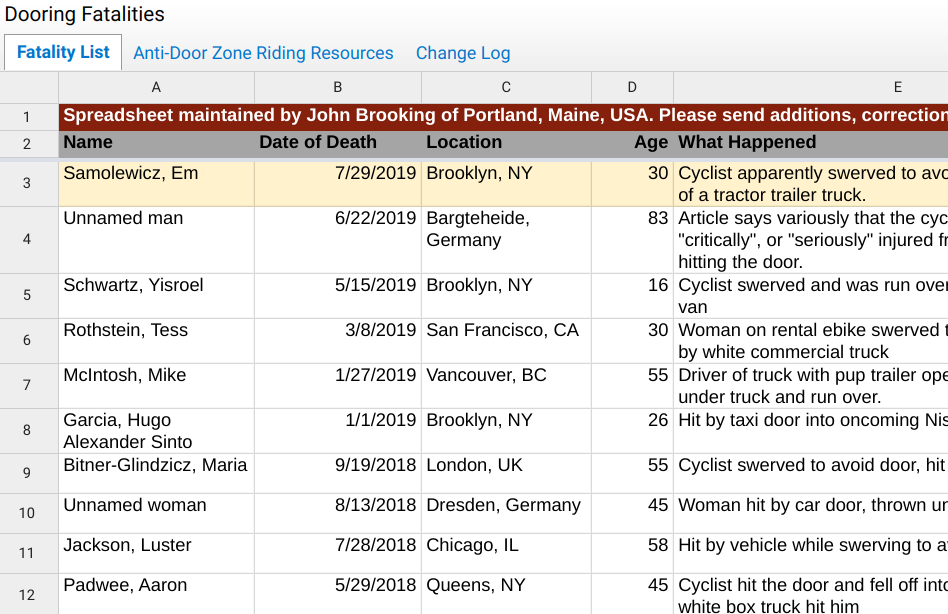
Volunteer registry of known dooring fatalities by name, date, location, circumstances, linked references. Maintained by John Brooking, USA. Publicly sourced.
"NOT LOOKING" MAJOR FACTOR IN CRASHES
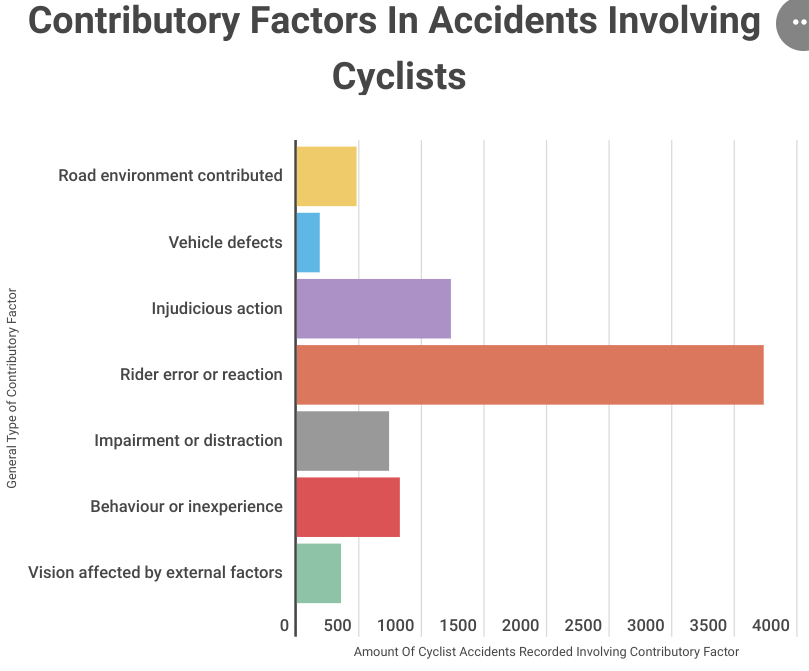
Contributing factors to cycling causalties in UK."As the bar graph shows, by far the largest cause of accidents involving cyclists is Rider Error Or Reaction. Within this category, the vast majority of accidents come from “driver/rider failed to look properly” - recorded as a contributory factor for over 2100 accidents. " Source: UK vs Europe - Cycling Accident Statistics , Harry Clark, March 18, 2019, BikeParts.co.uk.
VicRoads, State of Victoria, Australia
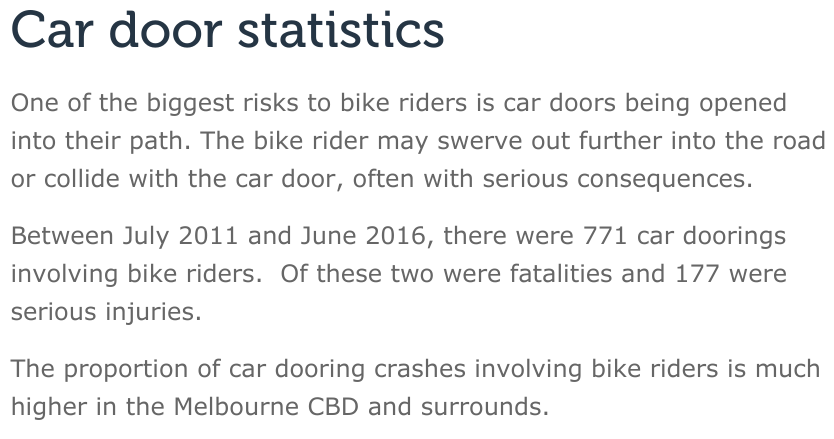
Between July 2011 and June 2016, there were 771 car doorings involving bike riders. Of these two were fatalities and 177 were serious injuries. Car doors & bike riders, VicRoads, Victoria, Australia.
One New Zealand Insurer's Dooring Claims
What is a 'Dutch Reach' and why every driver should use it New Zealand Herald, 5 Jan, 2020
Cycling Safety Study - Final Report. City of Vancouver, B.C.
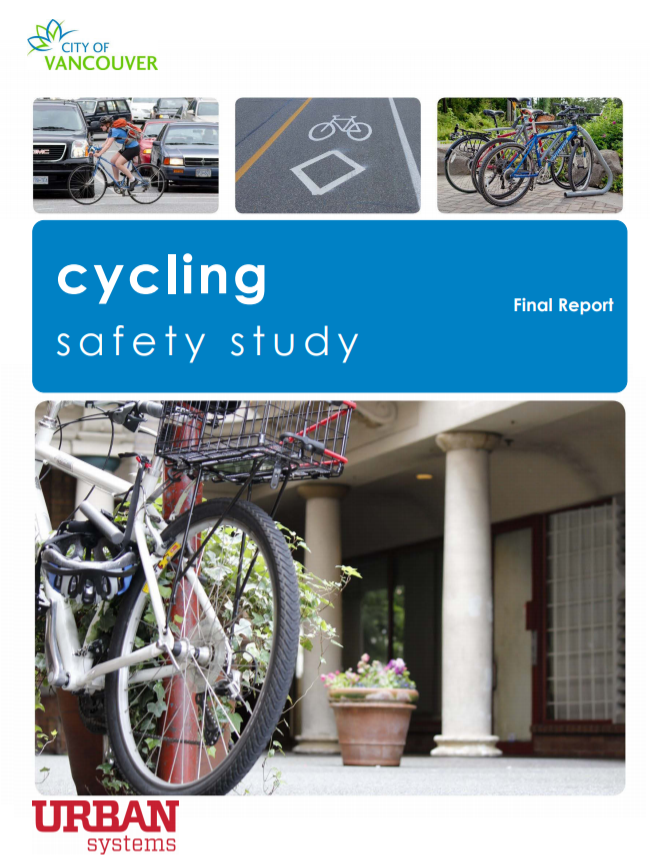
Cycling Safety Study Final Report 2015, City of Vancouver, British Columbia, Ca, by Urban Systems. Study finds doorings were the most common cause of bicycle collision injuries, and constituted 15.2% of all bike collisions.
Bikelane Design & Dooring Risk Research with Stats
Dooring Frequency in Vienna, Austria
"In 2018, a student from the Vienna University of Technology discovered for his bachelor's thesis that every tenth accident involving a bicycle in the federal capital was a dooring accident. The risk of accidents was particularly high on narrow multi-purpose strips, where cyclists are led directly past parked cars." - "DOORING"-UNFÄLLE - Der Griff, der Leben retten kann, Von APA, NÖN.at, Ausland, 11. Mai 2020.
Toronto: Doorings in 2016 Up 58% over 2014
Cycle Toronto says the crashes, caused when a driver opens a car door into the path of a cyclist, increased 58.3 per cent between 2014 and 2016. One in six of all cyclist collisions (16.3%) were due to dooring. Read article.
Dooring Crisis - Chicago, Illinois, USA:
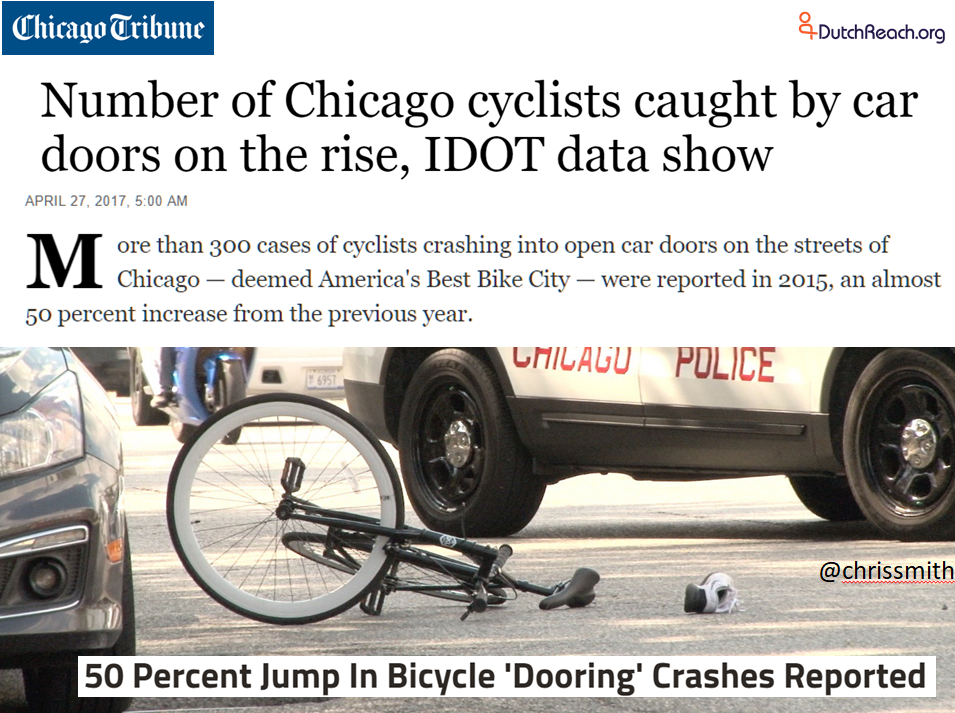
Chicago dooring crashes rose 50% from 2015 to 2016 according to Illinois Dept. of Transportation (IDOT). - Chicago Tribute, April 27, 2017. Click image for article. Also see: IDOT Finally Releases Its 2015 Chicago Crash Data, by John Greenfield, StreetsBlogCHI, Apr 17, 2017 which includes links to 2015 Chicago bike crash data.
Doorings – not just bicyclists
Doorings also afflict motorcyclists, moped riders, joggers, pedestrians, trucks, buses and even light rail. Drivers & passengers also put themselves - and their vehicle doors - at risk of injury, death or damages - as well as for traffic fines, insurance penalties, personal liability lawsuits, license suspension or revocation, job loss, and criminal charges.
For examples go to: Doorings – not just bicyclists.
Teaching Drivers the Dutch Reach to Prevent Dooring
Getting hit by an opening car door – dooring – is a fear of most bicyclists, especially on roadways with on-street parking. It is a common problem, but there is a simple solution, the Dutch Reach. The practice – which drivers in the Netherlands are trained and tested on prior to licensure, hence the name – calls for reaching over and using the right arm rather than the left to open a car door. (This applies to passengers, too. A passenger on the right side would use his left arm, and vice versa.)
Doing so requires the driver to turn or swivel so that his/her head and shoulders are looking back. That simple action makes it easy to see oncoming bicyclists and other vehicles through the side mirror before opening the door. Teaching novice and seasoned drivers to do this here in the U.S. could save lives. So far, Massachusetts has added the technique to its driver’s manual. Click here to watch a short video demonstrating the technique. Source: A Right to the Road: Understanding & Addressing Bicyclist Safety, Governors Highway Safety Association, p. 58 (2017).
#1 'Key Issue' for Victoria BC Cyclists
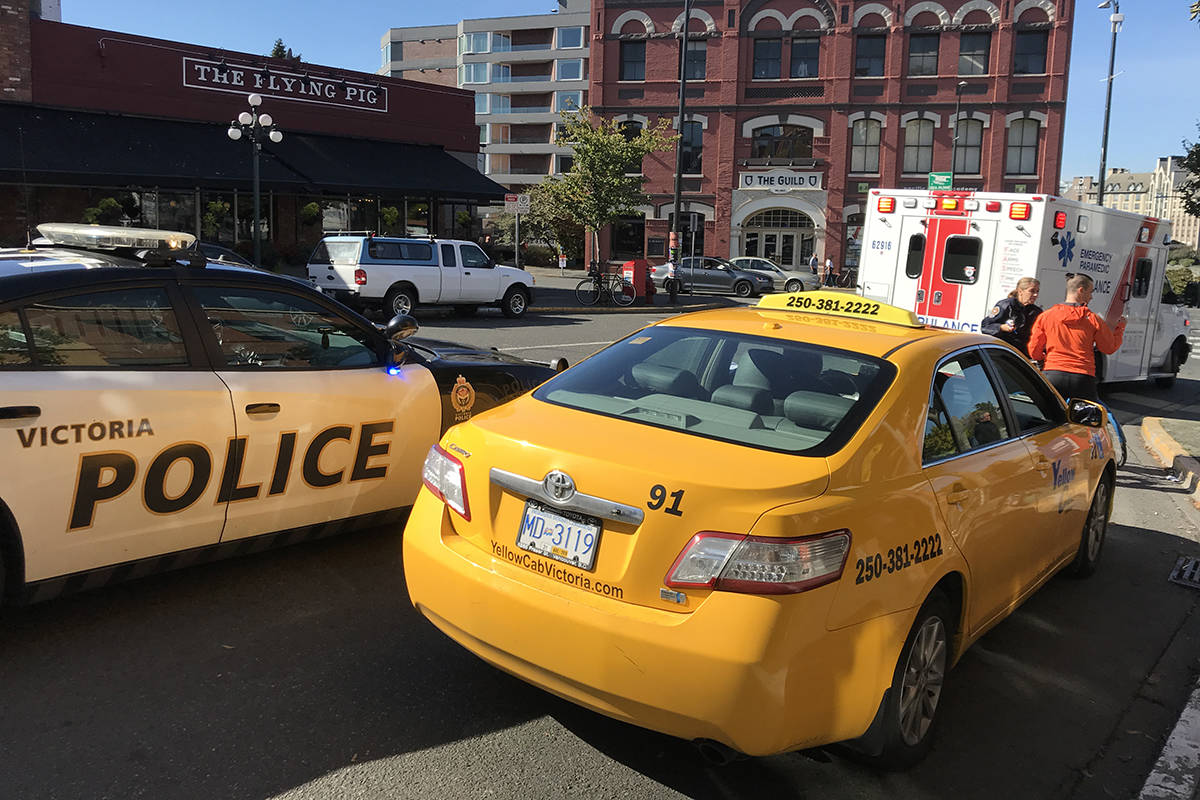
The scary truth about ‘dooring’, Victoria, BC, Ca., 9 Oct 2018.
2000 UK Cyclists Polled re: Dooring Experience
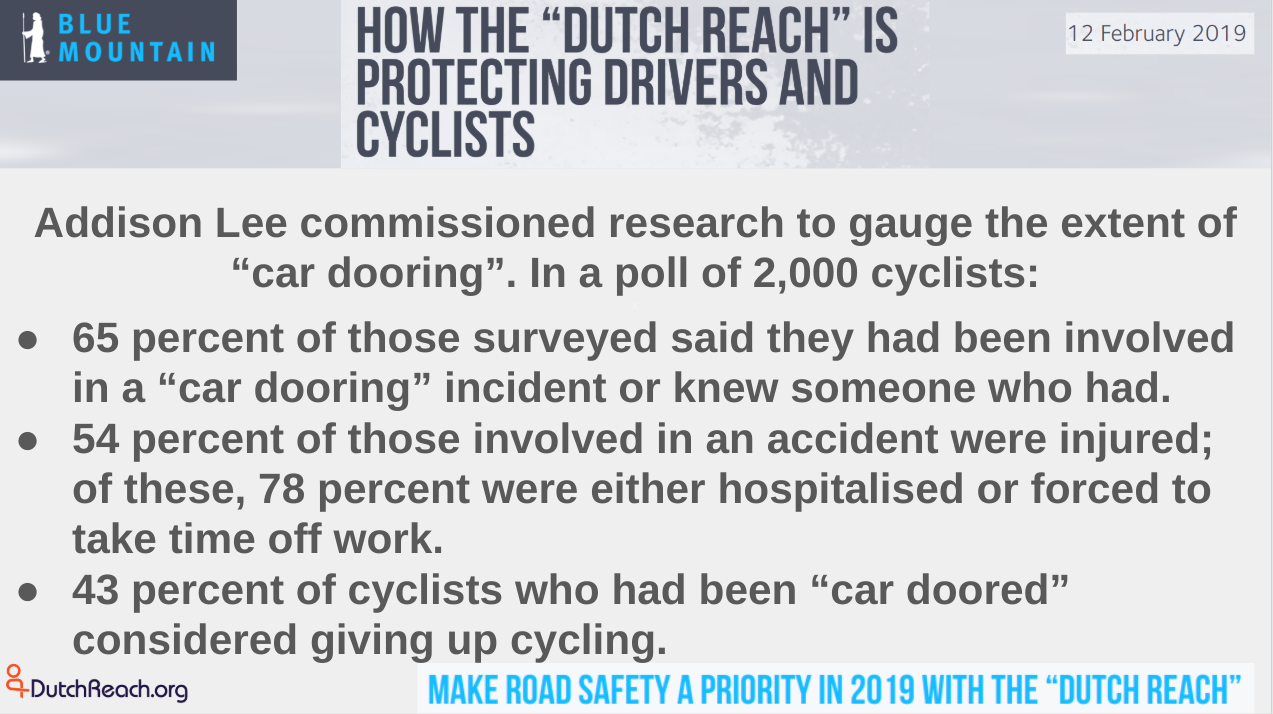
TNC Addison Lee commissioned research which polled 2000 UK cyclists to gauge the extent of “car dooring”. Source: How the "Dutch Reach" is saving lives of cyclists, February 12, 2019, Blue Mountain Group.
Occupant Failure in Majority of Doorings
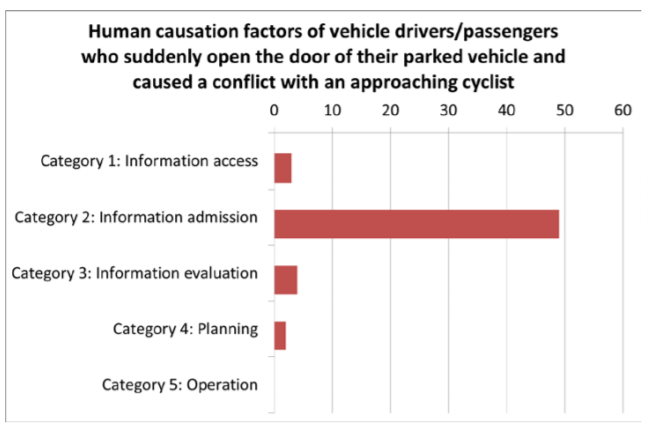
Fig. 8: Human failure categories of vehicle drivers or passengers who suddenly opened the door of their parked vehicle and caused a conflict with an approaching cyclist. - "In the majority of cases the vehicle driver or the passenger in the car would have been able to see the approaching cyclist....", p. 19, M. Jänsch, et al., IRCOBI Conf. 2015.
Dooring Risk Sudy, Austria
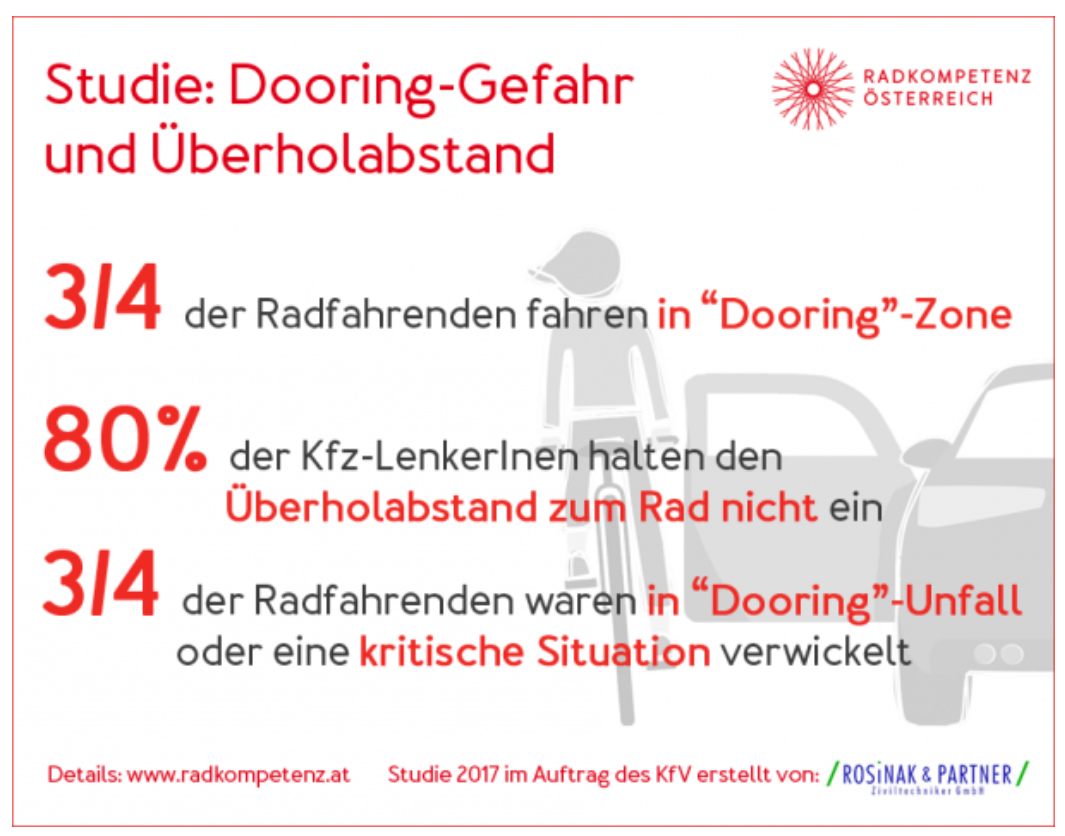
2017 Study on risks of cycling along side parked vehicles found 3/4ths of cyclists report dooring accident or critical situation with doors opening - Kuratorium für Verkehrssicherheit (KFV) [Road Safety Board of Trustees], Austria.
Dooring - GHSA Report
"...[D]ooring – when a bicyclist is hit by an open vehicle door – is a common form of bike-motor vehicle collision, particularly in urban areas. Chicago reported 300 cases of dooring in 2015, a 50 percent increase over the previous year (Vivanco, 2017). Forty states have a dooring law, with nearly all applying to motorists who leave their door open longer than necessary as well as opening the door without caution.
"A dooring law not only provides protection to bicyclists, but also other roadway users. The intent is to ensure that a person – the driver as well as other vehicle occupants – opens a door when it is safe and will not impede traffic, and that it remains open no longer than necessary. However, only three states’ laws – Massachusetts, Rhode Island and Oregon – specifically define bicyclists and pedestrians as part of traffic. Rhode Island’s law is particularly noteworthy because it applies to both sides of a vehicle when a door(s) is left open (LAB, 2017)."
A Right to the Road: Understanding & Addressing Bicyclist Safety, Governors Highway Safety Association, p. 41 (2017). https://www.ghsa.org/sites/default/files/2017-09/2017BicyclistSafetyReport-FINAL.pdf
Note: Caveats on Dooring Statistics
Definitional Issues re: Doorings
Technically, doorings include cyclist or VRU collisions with open or opening vehicle doors and also incidents of victims' forced avoidance of open or opening vehicle doors seeking to prevent collision, by veering, abrupt braking etc., with or without resulting injury. (See example here.) Dooring incidents should properly include subsequent crashes due to such evasion tactics. These include loss of control crashes and secondary collisions with passing traffic, pavement, other stationary objects or with the bike itself. Damage to the bicycle or motor vehicle without injury, or injury to an exiting occupant, also should be considered a dooring incident. More comprehensively, doorings include incidents even where potential victims avoid physical harm as negligent travel lane obstruction is an internationally recognized traffic violation.
In practice, however, such near-doorings are seldom if ever included, estimated or even mentioned. Yet the true frequency of near-dooring incidents is such that it is both under-recognized by the general public and yet a prominent concern among regular urban cyclists. Fear of doorings based on such personal experience or as common knowledge thus contributes to cyclist insecurity and discourages others from using bicycles for normal transport.
Non-Standard Reporting:
Further complicating the matter, reporting methods and practices are often lacking in quality or accuracy. Cyclists often do not report minor incidents or injuries. Police report forms are often oriented to vehicle vs vehicle incidents without adequate choices for characterizing doorings or other bicycle crashes. Even if forms are adequate, police training, ignorance or bias may also degrade reporting - and cyclists are advised to obtain filed police reports after such incidents to determine if the report accurately reflects the surviving cyclist's description of events. Data based on Emergency Medical Services calls and reports are a subset of doorings - those with initially evident, feared or suspected injury or fatality. More thorough studies of doorings and other cycling crashes with injuries often seek hospital or other medical reports in addition to official police filings.
Statistical Definitions Vary
Furthermore the statistical reports often do use the same standards across official or academic reports as classifying definitions and denominators vary. Is it a percentage of all bike/vehicle collisions or only those bike/vehicle collisions where the cyclist is deemed not at fault. Do incidence or prevalence rates include self-reports by cyclists or only police reported documented incidents? Are 'near-dooring' incidents reflected in official data (and thus influence education, prevention and enforcement efforts)?
Dilution by Extent: Dooring statistics tallied as a subset of large geographic areas - nation, province, state or county etc. are proportionally reduced if not lost among the total which include all conditions of bicycle use - practical and recreational cycling on rural roads or on trails, mountain biking, road races, and other cycling in suburban and ex-urban expanses. As a result, such total tallies do not capture the the endemic nature of doorings - where taxis, ride-share, parallel on-street parking and driver or passenger discharge from and into travel lanes are regular hazards.
Older vs newer cities: Older cities often have narrower streets where on-street parallel parking also predominates. Newer cities often have wider streets and feature more angled or off-street parking. equally populous but differentially dense versus sprawling municipalities will likely have different crash profiles. In cities with often narrow street widths, parallel on-street parking and higher vehicle & cycling density exist, doorings may be proportionately more frequent. Research to substantiate this reasonable inference is as yet lacking but it is noteworthy that recent studies reporting high dooring rates come from older and/or denser cities.
Are all types of doorings included? Are doorings with other vehicles or road users -- joggers, pedestrians, scooters, mopeds, motorcycles, cars, vans, trucks, buses, light rail etc., included in police reports and department statistics?
Boston Cyclist Safety Report 2013 - Doorings
Doorings in Boston by frequent road users - taxis, buses. Boston Cycling Safety Report 2013, pp. 44-45. Click to enlarge.
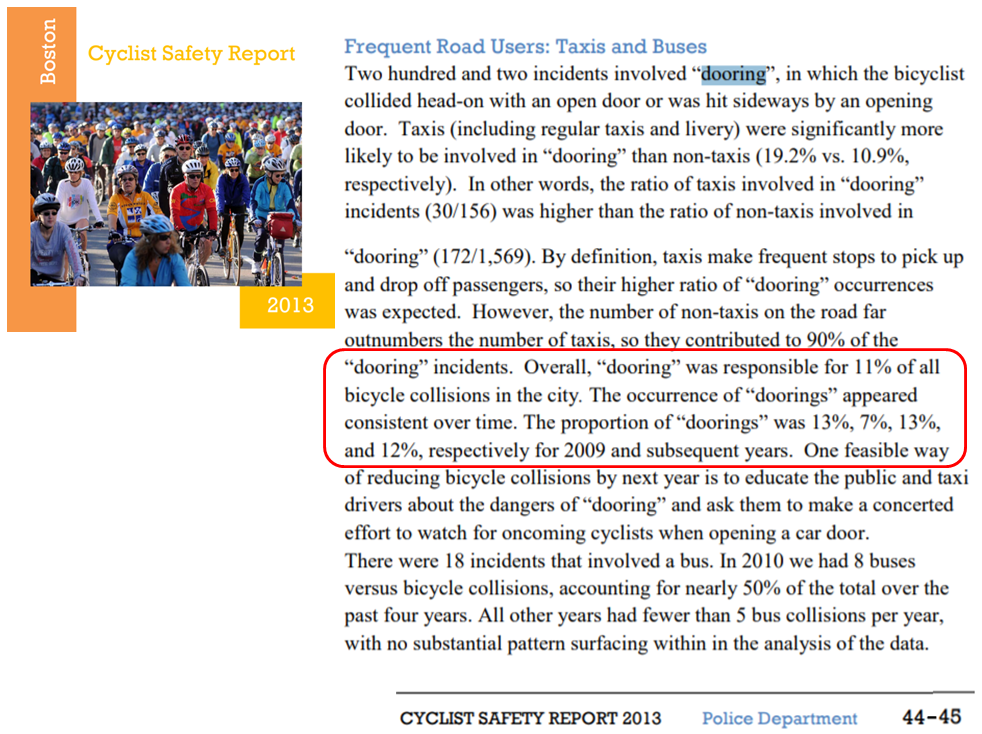
Doorings in Boston by frequent road users - taxis, buses & overall.. Boston Cycling Safety Report 2013, pp. 44-45. Click to enlarge.
"Overall, “dooring” was responsible for 11% of all bicycle collisions in the city. The occurrence of “doorings” appeared consistent over time. The proportion of “doorings” was 13%, 7%, 13%, and 12%, respectively for 2009 and subsequent years..
--Boston Cyclist Safety Report, 2013, p. 45.
Boston EMS Response Reports for Cycling Incidents
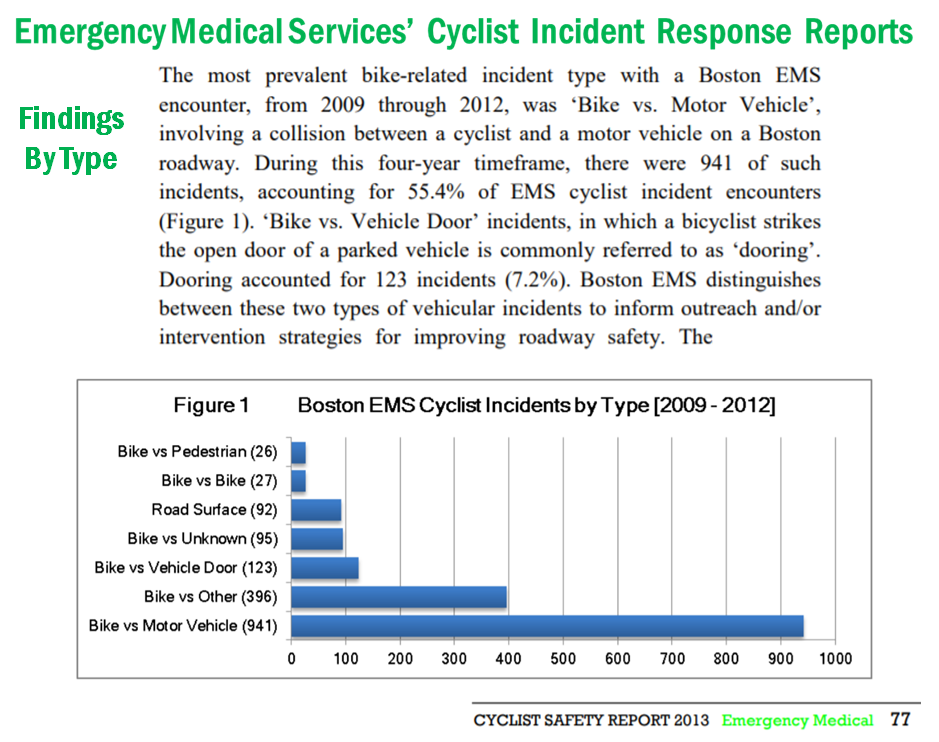
EMS cycling incident response reports 2009-2012 by type (subset of total bike-vehicle incidents). Boston Cycling Safety Report Part III (2013) p.77
'Near Doorings' are: rarely if ever reported
Doored! - Canadian "Dooring" Stats Database
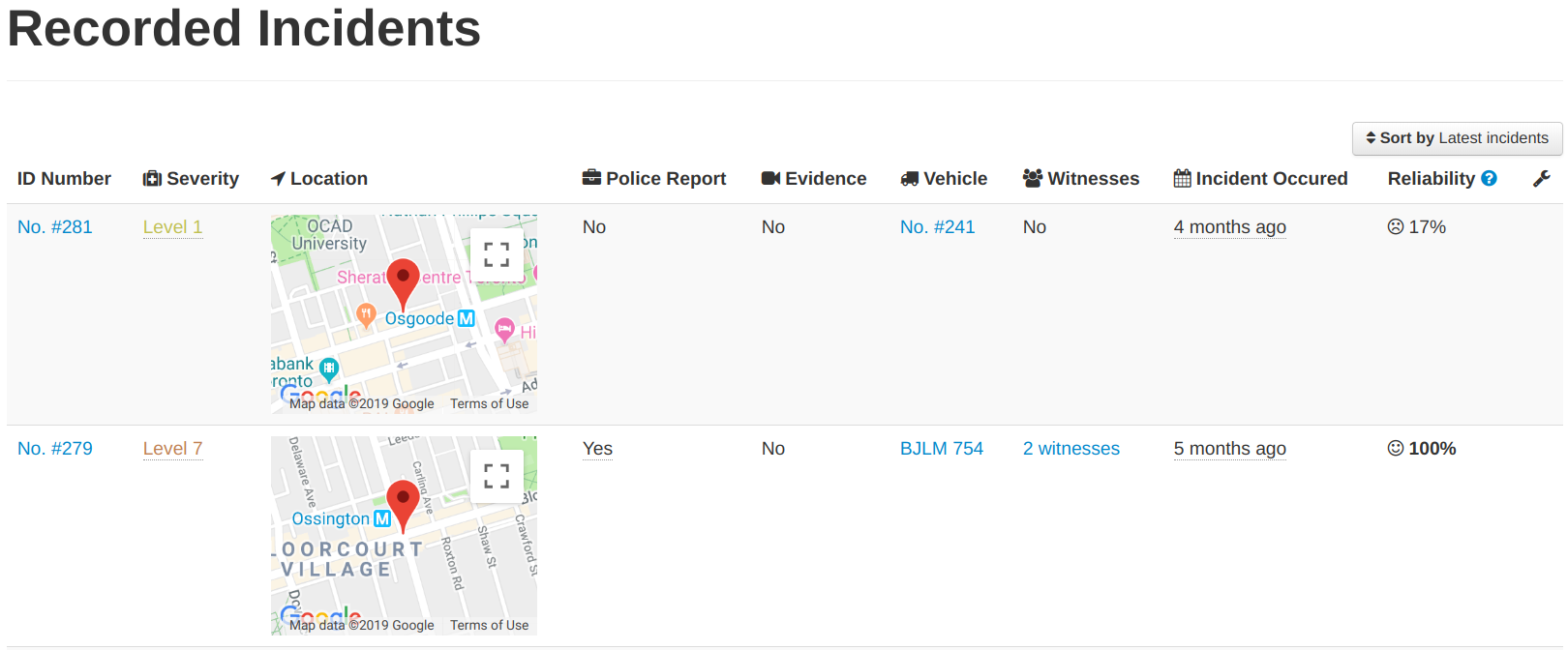
Website reporting of Canadian dooring incidents by date, location, severity, documentation, etc. Go to site.
Occupant Location in Dooring Incidents
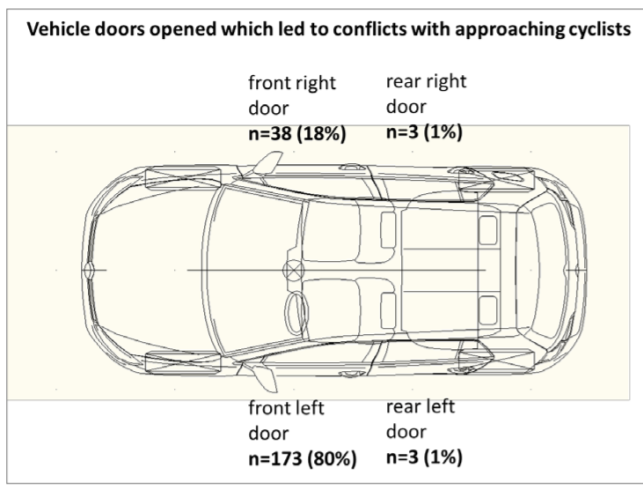
Fig. 3: Location of vehicle door which led to a conflict with a cyclist. M. Jänsch, et al., IRCOBI Conf. 2015. p. 15.
Crash Distribution in Dooring Incidents

Table 1 - Distribution of collision opponents of cyclists who had a conflict with an opening car door. p. 15, M. Jänsch, et al., IRCOBI Conf. 2015.
Bicycle Dooring Investigation, Germany, 2015
Investigation of bicycle accidents involving collisions with the opening door of parking vehicles and demands for a suitable driver assistance system. M. Jänsch, D. Otte, H. Johannsen, IRC-15-11, IRCOBI Conference 2015, 21 pp.
"The accidents mainly happen because the vehicle occupants are not making sure that the road is clear before opening the door. Visibility problems due to visual obstruction i.e., from bodywork or pillars of thevehicle were not found to be a major factor in these accidents. Thus to avoid these accidents it is sensible to warn the vehicle occupants about approaching cyclists. ..." [From Conclusion, p.20].
Paper also indicates dooring victims' injuries are anatomically comparable to other bicyclists' crash injuries. Helmets appear to reduce head injury compared to non-helmet users, and conflict with pavement accounts for most dooring incident head injuries. About one percent of total reported doorings caused bicyclist fatality.
The researchers conclude that warning assistance devices for vehicle occupants could significantly reduce dooring incidents by overcoming occupant failure to look if the way is clear before opening.
Door Fear 80% in Australia
#Dooring - Australian Cyclists' biggest fear | RACV https://t.co/sDRI68lb6P #doorzone #bikesafety #crash #crashnotaccident #cyclist #bicyclist #DOT #visionzero #VRU #DutchReach
— Michael Charney (@DutchReach) May 6, 2022
UK 2021 Awareness Now 15%
IAM RoadSmart surveyed 10,000 people and a resounding 85% were unaware of what the #DutchReach is.
This highlights the need for all #drivers, not just learners, to familiarise themselves with this new measure. https://t.co/C1Pg6aWXaT #HighwayCode pic.twitter.com/c24EtYBuoj
— Hi Vue Fresnel Lens (@NoBlindspot) October 11, 2021
